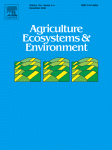Ver ítem
- xmlui.general.dspace_homeCentros Regionales y EEAsCentro Regional Buenos Aires SurEEA BalcarceArtículos científicosxmlui.ArtifactBrowser.ItemViewer.trail
- Inicio
- Centros Regionales y EEAs
- Centro Regional Buenos Aires Sur
- EEA Balcarce
- Artículos científicos
- Ver ítem
Balancing yield and environmental impact: The role of split nitrogen application and fertilizer type in corn production
Resumen
Management strategies for nitrogen (N) fertilization could help reducing gaseous N losses, environmental costs, and maize yield gaps. The objective of our study was to evaluate the effect of N sources and split N applications on gaseous emissions, environmental costs, and maize productivity under different water regimes. Field experiments were conducted in two growing seasons. Nine treatments were evaluated under rainfed and irrigated water management, a
[ver mas...]
Management strategies for nitrogen (N) fertilization could help reducing gaseous N losses, environmental costs, and maize yield gaps. The objective of our study was to evaluate the effect of N sources and split N applications on gaseous emissions, environmental costs, and maize productivity under different water regimes. Field experiments were conducted in two growing seasons. Nine treatments were evaluated under rainfed and irrigated water management, a control (no N fertilizer), and eight combinations of N sources (n = 4) and fertilization strategies (n = 2). The N sources were: urea, urea coated with urease activity or nitrification inhibitors (Urea-Limus and Urea-DMPP, respectively), and calcium-ammonium nitrate (CAN). Fertilization strategies were: single fertilizer application at fourth leaf stage (V4) and a split N application [60 % at V4, and 40 % at silking]. Ammonia volatilization losses and nitrous oxide (N2O) emissions were measured after fertilization and grain yield. Results showed that: a) Urea-Limus split application reduced ammonia volatilization compared to complete and split Urea in both seasons and water regimes (-80 % and −70 %, respectively), b) N2O emissions represented between 0.01 % and 0.14 % N applied, c) grain yield ranged from 8.3 to 19.0 Mg ha−1, d) none of the treatments affected N2O emissions nor maize grain yield, and e) environmental costs ranged from 1.1 to 108.6 U$S ha−1 and followed the same trend as volatilization losses. Under the environmental conditions of our study, we demonstrated that N source selection and split N application are promising strategies to reduce gaseous emissions and their environmental costs without affecting yield.
[Cerrar]

Autor
Iglesias, M. Paula;
Wyngaard, Nicolás;
Lewczuk, Nuria;
Sainz Rozas, Hernan Rene;
Toribio, M.;
García, Fernando O.;
Reussi Calvo, Nahuel Ignacio;
Fuente
Agriculture, Ecosystems & Environment 392 : 109756 (October 2025)
Fecha
2025-05-14
Editorial
Elsevier
ISSN
0167-8809 (Print)
1873-2305 (Online)
1873-2305 (Online)
Documentos Relacionados
Formato
pdf
Tipo de documento
artículo
Proyectos
(ver más)
INTA/2023-PE-L01-I012, Intensificación Sostenible de la Agricultura Extensiva en la Región Pampeana
Palabras Claves
Derechos de acceso
Restringido
 Excepto donde se diga explicitamente, este item se publica bajo la siguiente descripción: Creative Commons Attribution-NonCommercial-ShareAlike 2.5 Unported (CC BY-NC-SA 2.5)
Excepto donde se diga explicitamente, este item se publica bajo la siguiente descripción: Creative Commons Attribution-NonCommercial-ShareAlike 2.5 Unported (CC BY-NC-SA 2.5)


